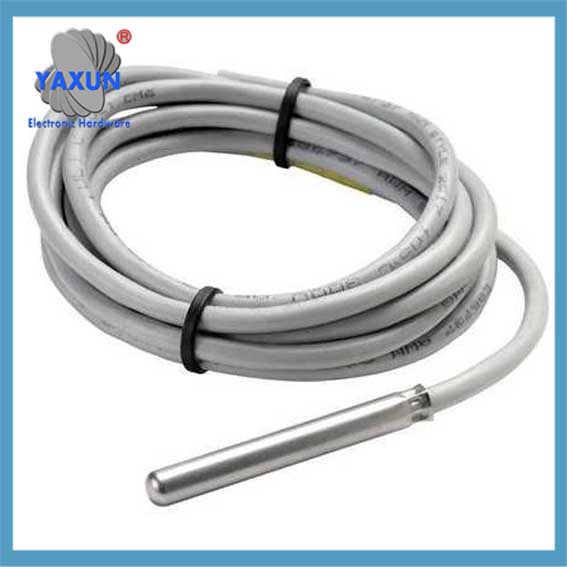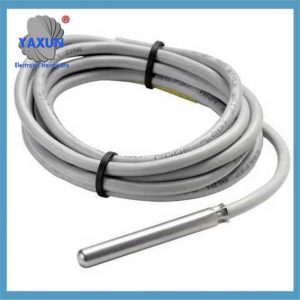produktkategori
- Termisk säkring 32
- ytmonterade säkringar 12
- termistor 36
- PCB-monterad säkringshållare 27
- Ledningsnät 6
- Bladsäkringshållare 17
- termostat 50
- Elektrisk säkring 24
- Biltemperatursensor 7
- Termisk effektbrytare 22
- Säkringsboxhållare 36
- Temperatursensor 75
- Termobrytare 68
- Bilsäkring 20
- Skruva fast säkringar 8
Produkttaggar
NTC, PTC, PT100, DS18B20 för temperatursondsgivare
Termoelementsond: Den använder den termoelektriska effekten för att mäta temperatur, och har egenskaperna hos ett brett mätområde och snabb svarshastighet.
Termisk resistanssond: använder egenskapen att motståndet hos metall eller halvledarmaterial ändras med temperaturen för att mäta temperatur, och har egenskaperna hög mätnoggrannhet och god stabilitet.
Halvledarsond: använder egenskapen att ledningsförmågan hos halvledarmaterial ändras med temperaturen för att mäta temperatur, och har egenskaperna av liten storlek, låg vikt och låg strömförbrukning.
NTC, PTC, PT100, DS18B20 Temperature probes and temperature sensors play an important role in the field of temperature measurement. The following is a detailed introduction to temperature probe sensors:
There are many types of temperature sensors, inklusive:
Termoelöpning
These sensors are made of two dissimilar metals that connect at two points to form a junction. They are reliable, accurate, and can operate over a wide range of temperatures.
Motståndstemperaturdetektorer (FoTU:er)
These sensors are based on the change in resistance of a metal as the temperature changes.
Termistorer
These sensors use the temperature characteristics of semiconductor resistors, which change resistance as the temperature changes. Thermistors are sensitive and have high accuracy relative to their cost.
Negativ temperaturkoefficient (NTC) termistorer
These sensors are sensitive and can respond to very small temperature changes. They have a temperature range of -50 ° C till 250 °C.
Resistive temperature detectors
These sensors have positive temperature coefficients (PTC) and offer precise temperature measurements. Dock, they have poor sensitivity.
1. Definition and working principle
Temperature probe:
Definition: A temperature probe is a device specifically used to measure temperature, and its core component is a temperature-sensitive element.
Arbetsprincip: A temperature probe uses sensitive elements (such as thermocouples, thermal resistors, semiconductors, etc.) to convert temperature changes into electrical signals for subsequent circuit processing or display.
Temperature sensor:
Definition: A temperature sensor is a broader concept that includes a temperature probe and a signal processing circuit connected to it.
Arbetsprincip: A temperature sensor not only includes a sensitive element, but also has a signal processing circuit that can complete the acquisition, processing and output of temperature signals, usually in the form of digital or analog signals.
2. Types and characteristics
Temperature probe type:
Termoelementsond: Den använder den termoelektriska effekten för att mäta temperatur, och har egenskaperna hos ett brett mätområde och snabb svarshastighet.
Termisk resistanssond: använder egenskapen att motståndet hos metall eller halvledarmaterial ändras med temperaturen för att mäta temperatur, och har egenskaperna hög mätnoggrannhet och god stabilitet.
Halvledarsond: använder egenskapen att ledningsförmågan hos halvledarmaterial ändras med temperaturen för att mäta temperatur, och har egenskaperna av liten storlek, låg vikt och låg strömförbrukning.
Temperature sensor type:
Analog temperature sensor: outputs analog signals, which need to be converted into digital signals by analog-to-digital converters for subsequent processing.
Digital temperature sensor: directly outputs digital signals, has strong anti-interference ability, hög noggrannhet, and is easy to integrate into the control system.
Intelligent temperature sensor: has self-diagnosis, self-calibration, communication and other functions, and can realize remote monitoring and control.
3. Selection and application
Selection factors:
Application environment: Consider whether the measured environment has special conditions such as corrosiveness, high temperature, high pressure, etc., so as to select suitable materials and protection levels.
Mätområde: Select a suitable sensor according to the range of the temperature to be measured to ensure that the sensor can accurately measure within the required range.
Noggrannhetskrav: According to the accuracy requirements of the application for temperature measurement, select a sensor with corresponding accuracy.
Cost budget: Under the premise of ensuring performance, consider cost factors and choose cost-effective sensors.
Application areas:
Industriell automation: used to monitor temperature changes in industrial equipment, machines and production processes to ensure normal operation of equipment and product quality.
Medical industry: used in medical equipment, temperature monitoring instruments and drug storage equipment to monitor patient temperature, Omgivningstemperatur och läkemedelslagringsförhållanden.
Bilindustri: used in electric vehicle motors, kondensatorer, DC -omvandlare, laddningssystem, as well as automobile engines, växellådor, air conditioning systems and exhaust systems to monitor and control the temperature of various liquids and gases.
Agriculture and food processing industry: used in agricultural greenhouses, cold storage, food processing equipment and transport vehicles to monitor and control the temperature of agricultural products and food.
Other fields: such as air conditioning and refrigeration industry, military and aerospace industry, Internet of Things industry, etc. are also widely used.
Iv. Use and maintenance
Installation: Install the sensor correctly according to the installation instructions to ensure good contact between the sensor and the object to be measured and avoid measurement errors caused by improper installation.
Wiring: Correctly connect the signal line and power line of the sensor to ensure the stability and accuracy of signal transmission.
Calibration: Calibrate the sensor regularly to ensure that its measurement accuracy meets the application requirements. The calibration process usually involves placing the sensor in a known temperature environment, comparing the difference between its output value and the standard value, and making necessary adjustments.
Maintenance: Clean and maintain the sensor regularly to avoid dust, dirt, etc. that affect the measurement performance of the sensor. Samtidigt, pay attention to check whether the cable connection is loose or damaged, and replace damaged parts in time.
Sammanfattningsvis, temperature probe sensors have a wide range of applications and an important position in the field of temperature measurement. When selecting and using them, it is necessary to make comprehensive considerations based on the specific application scenarios and requirements to ensure the accuracy and reliability of the measurement results. If you have any other questions or need further help, please feel free to let me know.
Kontakta oss
Väntar på ditt mejl, vi kommer att svara dig inom 12 timmar med värdefull information du behövde.
 English
English Afrikaans
Afrikaans العربية
العربية বাংলা
বাংলা bosanski jezik
bosanski jezik Български
Български Català
Català 粤语
粤语 中文(简体)
中文(简体) 中文(漢字)
中文(漢字) Hrvatski
Hrvatski Čeština
Čeština Nederlands
Nederlands Eesti keel
Eesti keel Suomi
Suomi Français
Français Deutsch
Deutsch Ελληνικά
Ελληνικά हिन्दी; हिंदी
हिन्दी; हिंदी Magyar
Magyar Bahasa Indonesia
Bahasa Indonesia Italiano
Italiano 日本語
日本語 한국어
한국어 Latviešu valoda
Latviešu valoda Lietuvių kalba
Lietuvių kalba македонски јазик
македонски јазик Bahasa Melayu
Bahasa Melayu Norsk
Norsk پارسی
پارسی Polski
Polski Português
Português Română
Română Русский
Русский Cрпски језик
Cрпски језик Slovenčina
Slovenčina Slovenščina
Slovenščina Español
Español Svenska
Svenska ภาษาไทย
ภาษาไทย Türkçe
Türkçe Українська
Українська اردو
اردو Tiếng Việt
Tiếng Việt












